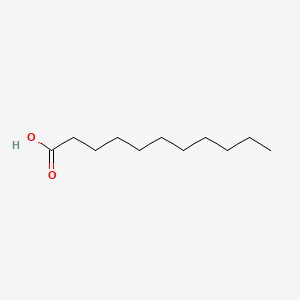| MeSH term | MeSH ID | Detail |
|---|---|---|
| Hemolysis | D006461 | 131 associated lipids |
| Alopecia | D000505 | 14 associated lipids |
UNDECANOIC ACID
UNDECANOIC ACID is a lipid of Fatty Acyls (FA) class. The involved functions are known as Anabolism, Mitosis, Transcriptional Activation, Mismatch Repair and Transcription, Genetic. Undecanoic acid often locates in Protoplasm and spindle microtubule. The associated genes with UNDECANOIC ACID are TERT gene. The related lipids are Fatty Acids and undecanoic acid.
Cross Reference
Introduction
To understand associated biological information of UNDECANOIC ACID, we collected biological information of abnormalities, associated pathways, cellular/molecular locations, biological functions, related genes/proteins, lipids and common seen animal/experimental models with organized paragraphs from literatures.
What diseases are associated with UNDECANOIC ACID?
There are no associated biomedical information in the current reference collection.
Possible diseases from mapped MeSH terms on references
We collected disease MeSH terms mapped to the references associated with UNDECANOIC ACID
PubChem Associated disorders and diseases
What pathways are associated with UNDECANOIC ACID
There are no associated biomedical information in the current reference collection.
PubChem Biomolecular Interactions and Pathways
Link to PubChem Biomolecular Interactions and PathwaysWhat cellular locations are associated with UNDECANOIC ACID?
Visualization in cellular structure
Associated locations are in red color. Not associated locations are in black.
Related references are published most in these journals:
| Location | Cross reference | Weighted score | Related literatures |
|---|
What functions are associated with UNDECANOIC ACID?
Related references are published most in these journals:
| Function | Cross reference | Weighted score | Related literatures |
|---|
What lipids are associated with UNDECANOIC ACID?
Related references are published most in these journals:
| Lipid concept | Cross reference | Weighted score | Related literatures |
|---|
What genes are associated with UNDECANOIC ACID?
Related references are published most in these journals:
| Gene | Cross reference | Weighted score | Related literatures |
|---|
What common seen animal models are associated with UNDECANOIC ACID?
There are no associated biomedical information in the current reference collection.
NCBI Entrez Crosslinks
All references with UNDECANOIC ACID
Download all related citations| Authors | Title | Published | Journal | PubMed Link |
|---|---|---|---|---|
| Yin AY et al. | Reexamination of pharmacokinetics of oral testosterone undecanoate in hypogonadal men with a new self-emulsifying formulation. | 2012 Mar-Apr | J. Androl. | pmid:21474786 |
| Lindenkamp N et al. | Genetically modified strains of Ralstonia eutropha H16 with β-ketothiolase gene deletions for production of copolyesters with defined 3-hydroxyvaleric acid contents. | 2012 | Appl. Environ. Microbiol. | pmid:22636005 |
| Saad F et al. | Testosterone as potential effective therapy in treatment of obesity in men with testosterone deficiency: a review. | 2012 | Curr Diabetes Rev | pmid:22268394 |
| Bera S et al. | Synthesis and antibacterial activities of amphiphilic neomycin B-based bilipid conjugates and fluorinated neomycin B-based lipids. | 2012 | Molecules | pmid:22858839 |
| Salam R et al. | Testosterone and metabolic syndrome: The link. | 2012 | Indian J Endocrinol Metab | pmid:22701831 |
| Lu YL et al. | Changes of pituitary and penile structure in male adult rats following castration and high-fat diet. | 2011 | J. Endocrinol. Invest. | pmid:20436268 |
| Piantadosi C et al. | The effect of testosterone and a nutritional supplement on hospital admissions in under-nourished, older people. | 2011 | BMC Geriatr | pmid:22023735 |
| Castela A et al. | Testosterone, endothelial health, and erectile function. | 2011 | ISRN Endocrinol | pmid:22363891 |
| Klenk HP et al. | Complete genome sequence of the thermophilic, hydrogen-oxidizing Bacillus tusciae type strain (T2) and reclassification in the new genus, Kyrpidia gen. nov. as Kyrpidia tusciae comb. nov. and emendation of the family Alicyclobacillaceae da Costa and Rainey, 2010. | 2011 | Stand Genomic Sci | pmid:22180816 |
| Wang Y et al. | A fluorescent fatty acid probe, DAUDA, selectively displaces two myristates bound in human serum albumin. | 2011 | Protein Sci. | pmid:21997768 |
